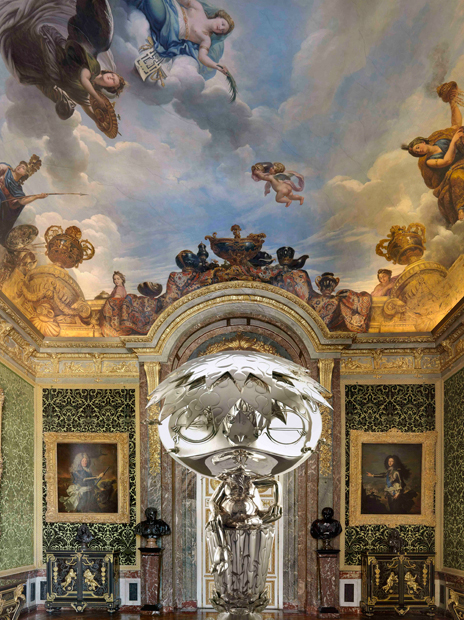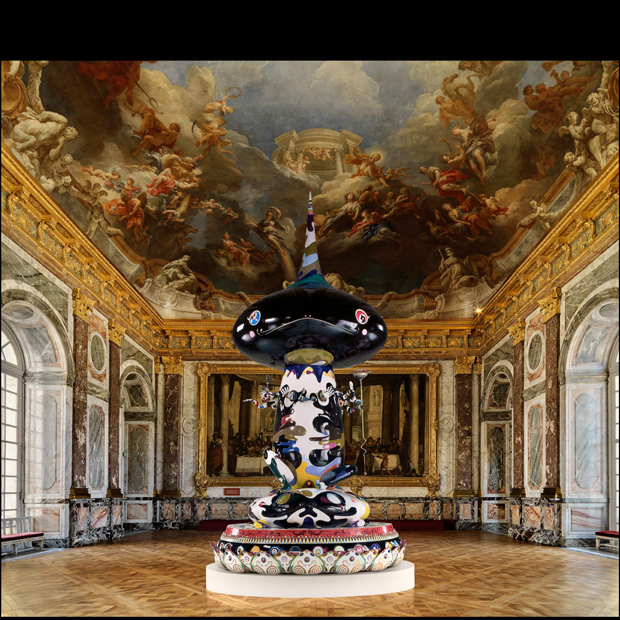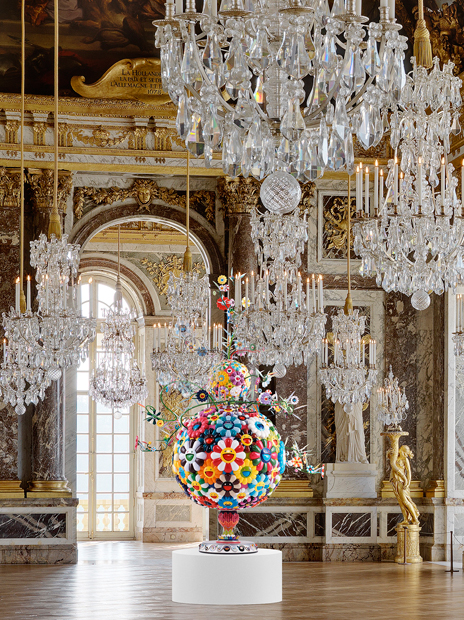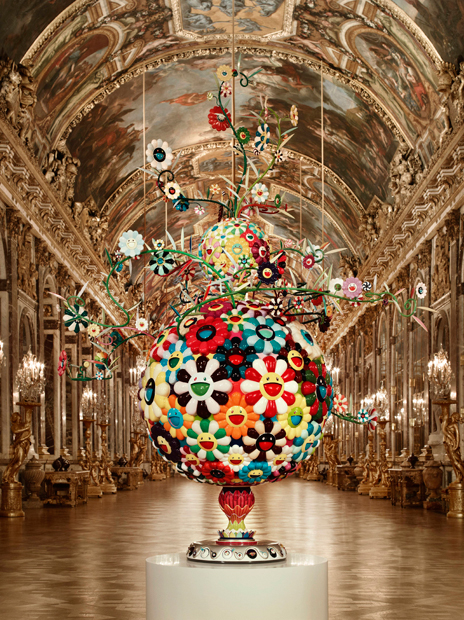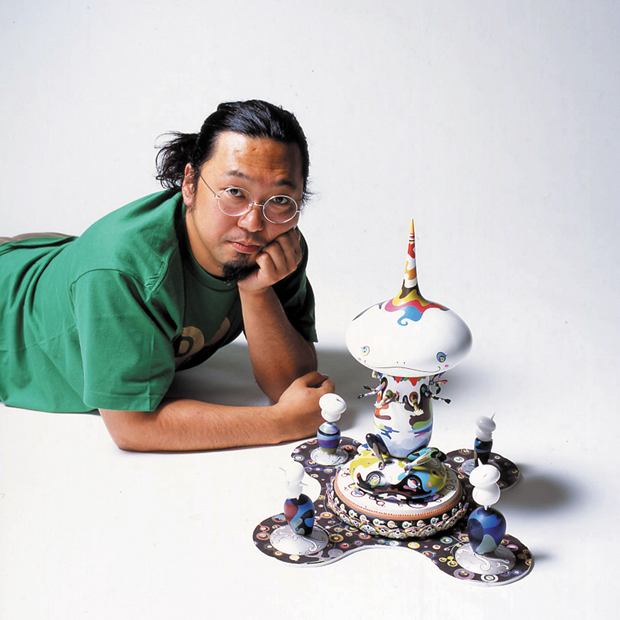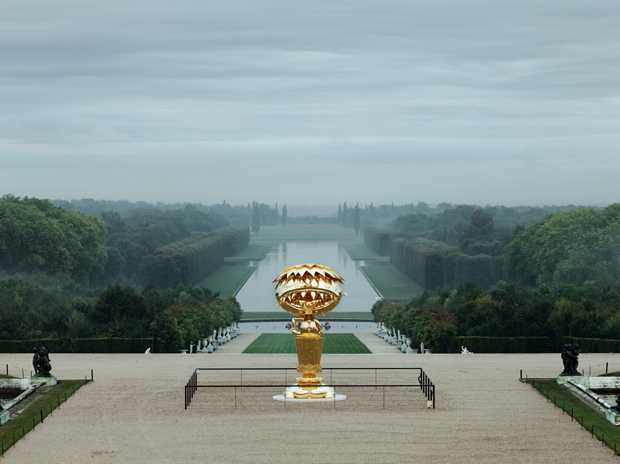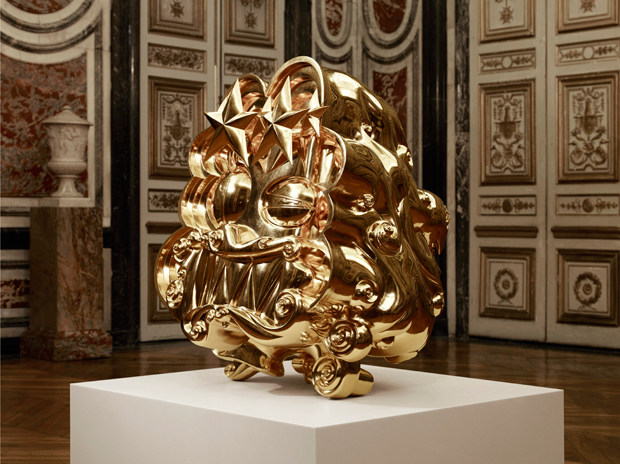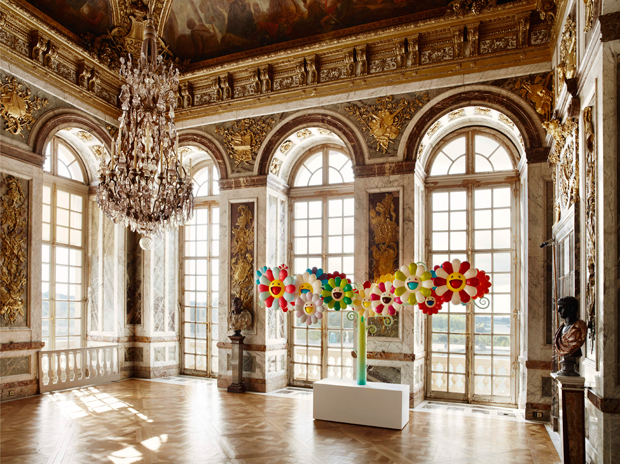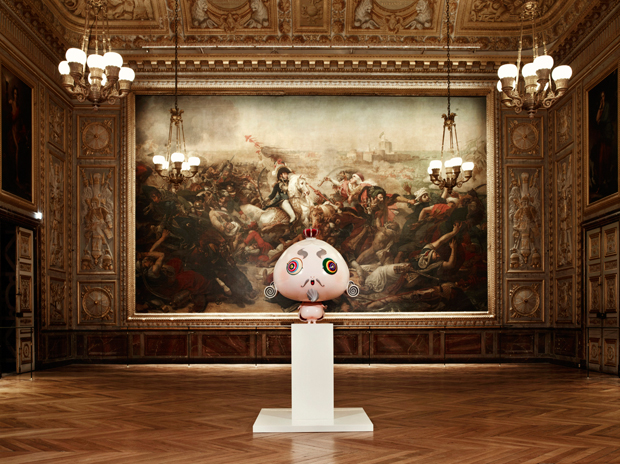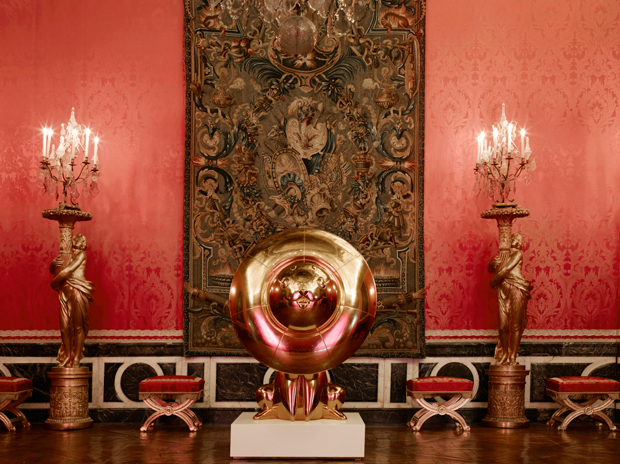
If the Château de Versailles represents the historical past, then Takashi Murakami represents the ultra-modern present. Whilst neither of these labels is in any way accurate, they do help us to illuminate what we know of both as we back away from our mistake.
In many ways it is hard to describe Takashi Murakami’s work. Employing such a diversity of material and media, and writing his stories with such a rich visual vocabulary, Murakami leaves a taste of saccharine lasciviousness in the palette one minute and then a sense of sublime bewilderment the next. The work re-processes the codified repetition of tropes, types and schema that run through Japanese visual traditions, challenging established notions of and re-examining the relationship between Japanese history and culture. He moves effortlessly between styles, from the exquisite classical Nihonga techniques that he studied for his PhD - such as the instantly recognizable ukiyo-e (floating world) woodcut prints - to the mass-produced and endlessly reforming post-war visual landscape of kawaii (cute) and manga culture. Thus we see the visual mantra of smiling characters and mushrooms endlessly floating through Murakami’s Superflat paintings, which take their defiantly two-dimensional graphic style and bright color planes from the supposedly low culture of anime and manga.
Other Murakami signatures include enormous and exquisitely wrought statues (some thirty feet high), which feature the same self referencing iconography and use of color, and the classically post-modern theme of mass producing and merchandizing art. Murakami’s art has featured on everything from elaborately customized Nike and Converse sneakers, to key chains and mouse pads, to his now iconic Louis Vuitton handbags. He created the artwork for rapper Kanye West’s Graduation album cover and then went on to animate his artwork for the fantastic music video for the single Good Morning. This process of reframing supposedly high and low artistic traditions and creating truly modern folk myths - phantasms and sprites that patrol contemporary culture - has conquered the multi-million dollar pinnacle of modern art. Murakami pieces regularly fetch extraordinary fees at auction and are displayed by the world’s most prestigious museums.
It seems that the etymology of the name Versailles is not clear, but most sources cite the Latin word versare, which means "to make more of, to keep on turning a new leaf". In medieval times this expression was commonly used to refer to plowed or cleared lands; lands that had been repeatedly "turned over".
So the name Versailles itself refers to evolution and revolution, to the refolding of the old into itself to create the new. The palace came into being as Louis XIV, seeking respite for he and his mistress from the strictures of court life, transformed and expanded an old hunting lodge of his father’s, eventually moving the court and government of France there in 1682. Master architects such as Le Vau and Jules Hardouin Mansart oversaw the design and development of the palace in the late 17th Century, establishing a vast complex still regarded by many as one of the most breathtaking buildings in the world, and which soon accommodated a court of anywhere between three to ten thousand people. The interiors were equally beautiful, with finely detailed frescos depicting scenes from the ancient classics and extolling the virtues of the current monarch. Most famous among the myriad of extraordinary attractions include the extravagance of the Hall of Mirrors, with its seventeen huge mirrored arches reflecting the seventeen equally impressive arcade windows that look out onto the palace’s gardens, themselves an expansive treasure known throughout the world for not only their size but their intricate and innovative landscape design.
This sense of change is a constant motif in the history of the Château de Versailles. Three more kings ruled France from the palace, each making their own increasingly elaborate and luxurious additions, until the French Revolution in 1789 removed them from power. However the Château de Versailles continued to play a deeply symbolic and pivotal role in history. The Emperor Napoleon maintained and used the palace as a residence at various points in his epic and bloody reign, and in a hugely symbolic act, victorious Prussian King Wilhelm I was declared Emperor of Germany at the palace at the conclusion of the Franco-Prussian War in 1871. Most famously of course, the Treaty of Versailles that settled peace in Europe after World War I was signed in the Hall of Mirrors in 1919 - a pivotal moment in world history whose ramifications are still being felt today.
It is difficult not to think of Château de Versailles as a giant consumerist spectacle. It was first the architectural and artistic fantasy that the monarchy wanted its subjects to consume. It was also the architects and artists’ mediation between what they thought the subjects expected of their King and their own interpretation of the myths kings expected their subjects to swallow as truth. Versailles played the King and his court back to himself, his court and his subjects - turning the leaf once more. Then as events overtook the palace, it became the myth we consumed of the decadence of the monarchy and of the past itself, and then glittering geo-political municipal hall where the bejeweled weight of history could bear witness to the momentous events of the present.
“I seek to produce a creative process which is a bridge between the past and the future”.
- Takashi Murakami
And so we come back to Takashi Murakami, whose work - much like the Château de Versailles - stands as an equally important symbol of cultural identity, mediating between art and history and challenging preconceived notions of both. Like a state visit from an advanced species from another galaxy, Murakami is sending his dreamlike creations as emissaries to the stately opulence of Château de Versailles. This temporary residence will comprise a walk where twenty two pieces (eleven created exclusively for the exhibition) will be located in the fifteen imposing rooms of the Château and the gardens. Here walkers can experience these two symbolic worlds as they are turned over and re-imagined by the juxtaposition, creating an alchemy that transforms how we see both host and guest:
“We understand, of course, that the fuse that sparked the fires of revolution led right through the center of the building. But in many ways, it all comes across as a fantastic tale from a kingdom far, far away. Just as the people of France might find it difficult to recreate in their minds an accurate image of the age of the Samurai, so too does the story of the palace become one that is, for us, diluted of reality.” Takashi Murakami on Murakami Versailles.
- Benjamin Stewart
Takashi Murakami at the Château de Versailles
Concept: Exhibition
Date: September 14th to December 12th 2010
Address: Place d´Armes
Versailles, 78000
Tel: 1 30 83 78 00
Website: www.chateauversailles-spectacles.fr
Photo Credit: Murakami Versailles 1: Takashi MURAKAMI
Oval Buddha Silver
2008
Sterling Silver - 4.47 x 2.64 x 2.55 feet / 136.5 x 80.5 x 78 cm
© 2008 Takashi Murakami/Kaikai Kiki Co., Ltd.All Rights Reserved.
Photo: Florian Kleinefenn - Château de Versailles/Salon de l’Abondance
Murakami Versailles 2: Takashi MURAKAMI
Tongari-Kun
2003-2004
Fiberglass, steel, and oil, acrylic, and urethane paint
22.96 x 11.48 feet / 700 x 350 cm
©2003-2004 Takashi Murakami/Kaikai Kiki Co., Ltd. All Rights Reserved.
Photo: Florian Kleinefenn - Salon d’Hercule / Château de Versailles
Murakami Versailles 3: Takashi MURAKAMI
Flower Matango (d)
2001-2006
Oil paint, acrylic, fiberglass and iron
10.33 x 6.7 x 8.63 feet / 315 x 204,7 x 263 cm
©2001-2006 Takashi Murakami/Kaikai Kiki Co., Ltd. All Rights Reserved.
Photo: Florian Kleinefenn - Galerie des Glaces / Château de Versailles
Murakami Versailles 4: Portrait de Takashi Murakami (avec la petite sculpture/with the little sculpture)
All Artworks © Takashi Murakami/Kaikai Kiki Co., Ltd. All Rights Reserved.
Photo: Kenji Yagi
Murakami Versailles 5: Takashi MURAKAMI
Flower Matango
2001-2006
Fiberglass, iron, oil paint and acrylic
315 x 204,7 x 263 cm / 10,33 x 6,7 x 8,63 feet
©2001-2006 Takashi Murakami/Kaikai Kiki Co., Ltd. All Rights Reserved.
Photo: Cedric Delsaux - The Hall of Mirrors / Château de Versailles
Murakami Versailles 6: Takashi MURAKAMI
J
2010
Aluminium and gold leaf
104 x 80 x 90 cm / 3,41 x 2,62 x 2,95 feet
©2010 Takashi Murakami/Kaikai Kiki Co., Ltd. All Rights Reserved.
Photo: Cedric Delsaux - The Queen’s Guards Room / Château de Versailles
Murakami Versailles 7: Takashi MURAKAMI
Oval Buddha
2007-2010
Bronze and gold leaf
568 x 312 x 319 cm / 18,6 x 10,46 x 10,21 feet
©2007-2010 Takashi Murakami/Kaikai Kiki Co., Ltd. All Rights Reserved.
Photo: Cedric Delsaux - Water Parterre / Château de Versailles
Murakami Versailles 8: Takashi MURAKAMI
Superflat Flowers
2010
Fiberglass reinforced plastic, carbon fiber, steel and acrylic
287 x 91 x 450 cm / 9,41 x 2,98 x 14,76 feet
©2010 Takashi Murakami/Kaikai Kiki Co., Ltd. All Rights Reserved.
Photo: Cedric Delsaux - The Salon of Peace / Château de Versailles
Murakami Versailles 9: Takashi Murakami
The Emperor’s New Clothes
2005
Fiberglass, resin, iron, wood, fabrics, oil paint, acrylic and lacquer
189 x 109 x 102 cm / 6,23 x 3,14 x 1,50 feet
©2005 Takashi Murakami/Kaikai Kiki Co., Ltd. All Rights Reserved.
Photo: Cedric Delsaux - The Coronation Room/ Château de Versailles
Murakami Versailles 10: Takashi Murakami
Yume Lion (The Dream Lion)
2009 -2010
Aluminium and gold leaf
191 x 127 x 110 cm / 6,3 feet x 50 ½ inches x 43 ¼ inches
©2009-2010 Takashi Murakami/Kaikai Kiki Co., Ltd. All Rights Reserved.
Photo: Cedric Delsaux - The Apollo Salon / Château de Versailles
In many ways it is hard to describe Takashi Murakami’s work. Employing such a diversity of material and media, and writing his stories with such a rich visual vocabulary, Murakami leaves a taste of saccharine lasciviousness in the palette one minute and then a sense of sublime bewilderment the next. The work re-processes the codified repetition of tropes, types and schema that run through Japanese visual traditions, challenging established notions of and re-examining the relationship between Japanese history and culture. He moves effortlessly between styles, from the exquisite classical Nihonga techniques that he studied for his PhD - such as the instantly recognizable ukiyo-e (floating world) woodcut prints - to the mass-produced and endlessly reforming post-war visual landscape of kawaii (cute) and manga culture. Thus we see the visual mantra of smiling characters and mushrooms endlessly floating through Murakami’s Superflat paintings, which take their defiantly two-dimensional graphic style and bright color planes from the supposedly low culture of anime and manga.
Other Murakami signatures include enormous and exquisitely wrought statues (some thirty feet high), which feature the same self referencing iconography and use of color, and the classically post-modern theme of mass producing and merchandizing art. Murakami’s art has featured on everything from elaborately customized Nike and Converse sneakers, to key chains and mouse pads, to his now iconic Louis Vuitton handbags. He created the artwork for rapper Kanye West’s Graduation album cover and then went on to animate his artwork for the fantastic music video for the single Good Morning. This process of reframing supposedly high and low artistic traditions and creating truly modern folk myths - phantasms and sprites that patrol contemporary culture - has conquered the multi-million dollar pinnacle of modern art. Murakami pieces regularly fetch extraordinary fees at auction and are displayed by the world’s most prestigious museums.
It seems that the etymology of the name Versailles is not clear, but most sources cite the Latin word versare, which means "to make more of, to keep on turning a new leaf". In medieval times this expression was commonly used to refer to plowed or cleared lands; lands that had been repeatedly "turned over".
So the name Versailles itself refers to evolution and revolution, to the refolding of the old into itself to create the new. The palace came into being as Louis XIV, seeking respite for he and his mistress from the strictures of court life, transformed and expanded an old hunting lodge of his father’s, eventually moving the court and government of France there in 1682. Master architects such as Le Vau and Jules Hardouin Mansart oversaw the design and development of the palace in the late 17th Century, establishing a vast complex still regarded by many as one of the most breathtaking buildings in the world, and which soon accommodated a court of anywhere between three to ten thousand people. The interiors were equally beautiful, with finely detailed frescos depicting scenes from the ancient classics and extolling the virtues of the current monarch. Most famous among the myriad of extraordinary attractions include the extravagance of the Hall of Mirrors, with its seventeen huge mirrored arches reflecting the seventeen equally impressive arcade windows that look out onto the palace’s gardens, themselves an expansive treasure known throughout the world for not only their size but their intricate and innovative landscape design.
This sense of change is a constant motif in the history of the Château de Versailles. Three more kings ruled France from the palace, each making their own increasingly elaborate and luxurious additions, until the French Revolution in 1789 removed them from power. However the Château de Versailles continued to play a deeply symbolic and pivotal role in history. The Emperor Napoleon maintained and used the palace as a residence at various points in his epic and bloody reign, and in a hugely symbolic act, victorious Prussian King Wilhelm I was declared Emperor of Germany at the palace at the conclusion of the Franco-Prussian War in 1871. Most famously of course, the Treaty of Versailles that settled peace in Europe after World War I was signed in the Hall of Mirrors in 1919 - a pivotal moment in world history whose ramifications are still being felt today.
It is difficult not to think of Château de Versailles as a giant consumerist spectacle. It was first the architectural and artistic fantasy that the monarchy wanted its subjects to consume. It was also the architects and artists’ mediation between what they thought the subjects expected of their King and their own interpretation of the myths kings expected their subjects to swallow as truth. Versailles played the King and his court back to himself, his court and his subjects - turning the leaf once more. Then as events overtook the palace, it became the myth we consumed of the decadence of the monarchy and of the past itself, and then glittering geo-political municipal hall where the bejeweled weight of history could bear witness to the momentous events of the present.
“I seek to produce a creative process which is a bridge between the past and the future”.
- Takashi Murakami
And so we come back to Takashi Murakami, whose work - much like the Château de Versailles - stands as an equally important symbol of cultural identity, mediating between art and history and challenging preconceived notions of both. Like a state visit from an advanced species from another galaxy, Murakami is sending his dreamlike creations as emissaries to the stately opulence of Château de Versailles. This temporary residence will comprise a walk where twenty two pieces (eleven created exclusively for the exhibition) will be located in the fifteen imposing rooms of the Château and the gardens. Here walkers can experience these two symbolic worlds as they are turned over and re-imagined by the juxtaposition, creating an alchemy that transforms how we see both host and guest:
“We understand, of course, that the fuse that sparked the fires of revolution led right through the center of the building. But in many ways, it all comes across as a fantastic tale from a kingdom far, far away. Just as the people of France might find it difficult to recreate in their minds an accurate image of the age of the Samurai, so too does the story of the palace become one that is, for us, diluted of reality.” Takashi Murakami on Murakami Versailles.
- Benjamin Stewart
Takashi Murakami at the Château de Versailles
Concept: Exhibition
Date: September 14th to December 12th 2010
Address: Place d´Armes
Versailles, 78000
Tel: 1 30 83 78 00
Website: www.chateauversailles-spectacles.fr
Photo Credit: Murakami Versailles 1: Takashi MURAKAMI
Oval Buddha Silver
2008
Sterling Silver - 4.47 x 2.64 x 2.55 feet / 136.5 x 80.5 x 78 cm
© 2008 Takashi Murakami/Kaikai Kiki Co., Ltd.All Rights Reserved.
Photo: Florian Kleinefenn - Château de Versailles/Salon de l’Abondance
Murakami Versailles 2: Takashi MURAKAMI
Tongari-Kun
2003-2004
Fiberglass, steel, and oil, acrylic, and urethane paint
22.96 x 11.48 feet / 700 x 350 cm
©2003-2004 Takashi Murakami/Kaikai Kiki Co., Ltd. All Rights Reserved.
Photo: Florian Kleinefenn - Salon d’Hercule / Château de Versailles
Murakami Versailles 3: Takashi MURAKAMI
Flower Matango (d)
2001-2006
Oil paint, acrylic, fiberglass and iron
10.33 x 6.7 x 8.63 feet / 315 x 204,7 x 263 cm
©2001-2006 Takashi Murakami/Kaikai Kiki Co., Ltd. All Rights Reserved.
Photo: Florian Kleinefenn - Galerie des Glaces / Château de Versailles
Murakami Versailles 4: Portrait de Takashi Murakami (avec la petite sculpture/with the little sculpture)
All Artworks © Takashi Murakami/Kaikai Kiki Co., Ltd. All Rights Reserved.
Photo: Kenji Yagi
Murakami Versailles 5: Takashi MURAKAMI
Flower Matango
2001-2006
Fiberglass, iron, oil paint and acrylic
315 x 204,7 x 263 cm / 10,33 x 6,7 x 8,63 feet
©2001-2006 Takashi Murakami/Kaikai Kiki Co., Ltd. All Rights Reserved.
Photo: Cedric Delsaux - The Hall of Mirrors / Château de Versailles
Murakami Versailles 6: Takashi MURAKAMI
J
2010
Aluminium and gold leaf
104 x 80 x 90 cm / 3,41 x 2,62 x 2,95 feet
©2010 Takashi Murakami/Kaikai Kiki Co., Ltd. All Rights Reserved.
Photo: Cedric Delsaux - The Queen’s Guards Room / Château de Versailles
Murakami Versailles 7: Takashi MURAKAMI
Oval Buddha
2007-2010
Bronze and gold leaf
568 x 312 x 319 cm / 18,6 x 10,46 x 10,21 feet
©2007-2010 Takashi Murakami/Kaikai Kiki Co., Ltd. All Rights Reserved.
Photo: Cedric Delsaux - Water Parterre / Château de Versailles
Murakami Versailles 8: Takashi MURAKAMI
Superflat Flowers
2010
Fiberglass reinforced plastic, carbon fiber, steel and acrylic
287 x 91 x 450 cm / 9,41 x 2,98 x 14,76 feet
©2010 Takashi Murakami/Kaikai Kiki Co., Ltd. All Rights Reserved.
Photo: Cedric Delsaux - The Salon of Peace / Château de Versailles
Murakami Versailles 9: Takashi Murakami
The Emperor’s New Clothes
2005
Fiberglass, resin, iron, wood, fabrics, oil paint, acrylic and lacquer
189 x 109 x 102 cm / 6,23 x 3,14 x 1,50 feet
©2005 Takashi Murakami/Kaikai Kiki Co., Ltd. All Rights Reserved.
Photo: Cedric Delsaux - The Coronation Room/ Château de Versailles
Murakami Versailles 10: Takashi Murakami
Yume Lion (The Dream Lion)
2009 -2010
Aluminium and gold leaf
191 x 127 x 110 cm / 6,3 feet x 50 ½ inches x 43 ¼ inches
©2009-2010 Takashi Murakami/Kaikai Kiki Co., Ltd. All Rights Reserved.
Photo: Cedric Delsaux - The Apollo Salon / Château de Versailles
Murakami Versailles







